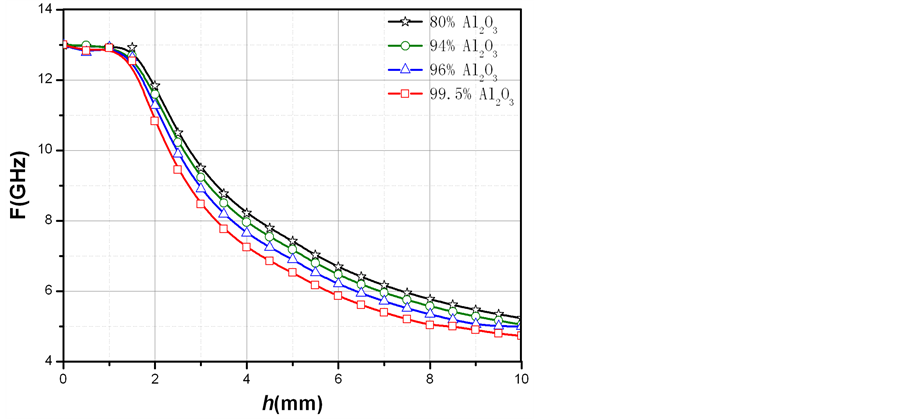1. 引言
铷气室型原子频标结构简单、体积小、重量轻,其短期稳定性与长期稳定性都很优越,广泛应用于导航与定位、数字通信、交通管理以及电网调节中[1] 。近年来,由于微机电系统即MEMS (Micro-Electro-Mechanic System)技术的迅速发展,铷原子频标的微小型化一直是研究热点,2004年美国国家标准局研制出基于MEMS技术的微型铷原子钟,体积与功耗都进一步降低[2] ;美国的其他研究机构与公司如桑迪亚国家实验室、Symmetricom公司也提出了各自的研究方案[3] [4] 。这些方案均是基于相干布居囚禁原理,虽然体积与功耗都可以降低,且基于激光的原子频标的短稳较高,但其长期稳定性无论在地面还是在空间都还没有得到实践检验。基于以前的工作[5] ,本课题组提出了一种微小型化的铷气室型原子频标[6] [7] 。它仍基于光抽运原理,物理部分的铷-87谱灯、铷-85滤光泡及铷-87吸收泡均采用MEMS技术设计加工制造,而6.83 GHz谐振腔则采用填充介质的TE101模式微波谐振腔。与基于相干布居囚禁原理的铷原子频标相比,基于光抽运原理的铷气室型原子频标,长稳与短稳在空间和地面的各种应用中都得到了长期验证。
微波谐振腔是铷气室型原子频标中的核心部件,也是微小型化的难点之一。国内外有关的研究单位与公司等都进行了研究。中科院武汉物理所研制的一种环极式微波腔[8] ,腔体积小、场模式为TE011,但加工难度大、精度难以保证。兰州物理所研制的圆柱型微波腔采用TE111模式[9] ,体积较大。美国Symmetricom将非标准结构的磁控管微波腔用于铷原子钟[10] [11] ,减小了体积。所研发出的这些微波谐振腔目前在4~8 cm3,有的腔体积较大是为了配合传统的体积较大的圆柱型铷-85滤光泡与铷-87吸收泡。本课题组提出的TE101模式矩形腔是可以获得体积最小的标准腔,并且通过填充介质体积可进一步减小。填充后余下的矩形空间非常适合放置用MEMS技术设计加工的铷-85滤光泡、铷-87吸收泡及光电管。基于MEMS技术的滤光泡与吸收泡都呈芯片状[12] [13] ,面积约1 cm2,厚度仅为1.2 mm,所占体积非常小,光电管的尺寸也可设计加工成相近的尺寸。本文正是从理论与实践上研究用于铷气室型微小型原子频标的6.83 GHz微波谐振腔。
2. 谐振腔原理分析与设计
铷原子频标的量子部分主要包括 无极放电光谱灯、
无极放电光谱灯、 滤光泡、
滤光泡、 吸收泡以及光电管。如图1所示为本文设计的微小型化铷原子频标的腔泡结构图,填充有陶瓷介质的微波谐振腔中,集成了光电管、吸收泡和滤光泡。由腔外
吸收泡以及光电管。如图1所示为本文设计的微小型化铷原子频标的腔泡结构图,填充有陶瓷介质的微波谐振腔中,集成了光电管、吸收泡和滤光泡。由腔外 光谱灯发出含有超精细结构a和b成分的D1线和D2线,该光线经过
光谱灯发出含有超精细结构a和b成分的D1线和D2线,该光线经过 滤光泡后,谱线中的a线被滤光泡吸收掉大部分,剩下的谱线主要为b成分。在吸收泡中,通过光抽运作用的
滤光泡后,谱线中的a线被滤光泡吸收掉大部分,剩下的谱线主要为b成分。在吸收泡中,通过光抽运作用的 原子大部分都处在F = 2态,不再吸收以b线为主的抽运光了,处在吸收泡后面的光电探测管就能接收到一定强度的光。这时如果在谐振腔上加上频率为
原子大部分都处在F = 2态,不再吸收以b线为主的抽运光了,处在吸收泡后面的光电探测管就能接收到一定强度的光。这时如果在谐振腔上加上频率为 原子基态超精细分裂值即6.83 GHz的微波磁场时,就会使
原子基态超精细分裂值即6.83 GHz的微波磁场时,就会使 原子发生能级跃迁,使抽运光的光强减弱,进而由光电管检测出来,这样随着微波频率的变化,光电流就描绘出一条共振曲线,得到
原子发生能级跃迁,使抽运光的光强减弱,进而由光电管检测出来,这样随着微波频率的变化,光电流就描绘出一条共振曲线,得到 原子的吸收谱线。这个信号经过调制,放大和伺服电路的控制,就可以把晶体振荡器的频率锁定在共振谱线中心,从而构成原子频率标准。
原子的吸收谱线。这个信号经过调制,放大和伺服电路的控制,就可以把晶体振荡器的频率锁定在共振谱线中心,从而构成原子频率标准。
本文探讨用于铷原子频标的矩形谐振腔,取基模为TE101,该模式电磁场分布均匀,腔Q值大,且电磁场主要分布在腔中心轴线部分,利于探针激励,并且也是原子和微波共振的主要区域,明显优于其他模式。在微波谐振腔外缠绕有C场线圈,起磁屏蔽作用,其场强远小于铷频标中的场强。除C场项圈外,谐振腔的墙壁上设有集成片状或线圈加热器。先前研究的实验结果[5] 表明,当谐振腔被加热至80~85℃时,铷滤光泡与吸收泡中的铷蒸汽压最适合进行光抽运。对于C场线圈与加热器,不在本文中研究。
2.1. 电磁场分析
当矩形谐振腔内无填充材料时,TEmnl和TMmnl模的谐振腔频率如下[14]
 (1)
(1)
式中,a,b,d分别是矩形谐振腔的长宽高, 和
和 分别是填充腔体材料的磁导率和介电常数,可见谐振频率与谐振腔的尺寸成反比关系。
分别是填充腔体材料的磁导率和介电常数,可见谐振频率与谐振腔的尺寸成反比关系。
铷气室型原子频标所需频率为6.83 GHz,模式选基模TE101,即m = 1,n = 0,l = 1,可得
 (2)
(2)
由上式可知,在TE101模式下,频率与谐振腔宽度无关。当 时,谐振腔的体积取最小值则为
时,谐振腔的体积取最小值则为

 (3)
(3)
考虑到谐振腔尺寸加工的协调性以及与MEMS滤光泡等的配合,b取值最好大于1 cm,则体积V最小值为9.66 ,该体积尺寸较大,需进一步缩减谐振腔尺寸。由式(1)可得频率与尺寸成反比,进一步减小腔尺寸会导致腔谐振频率增大。因此,研究中通过在空腔内填充高介电常数、低损耗的材料,来获得谐振频率为6.83 GHz的微小型化谐振腔。空腔的电磁场分析是研究的出发点,填充介质后的谐振腔,电磁场情况较复杂,进一步的研究需采用Ansoft HFSS软件来进行。
,该体积尺寸较大,需进一步缩减谐振腔尺寸。由式(1)可得频率与尺寸成反比,进一步减小腔尺寸会导致腔谐振频率增大。因此,研究中通过在空腔内填充高介电常数、低损耗的材料,来获得谐振频率为6.83 GHz的微小型化谐振腔。空腔的电磁场分析是研究的出发点,填充介质后的谐振腔,电磁场情况较复杂,进一步的研究需采用Ansoft HFSS软件来进行。
2.2. 激励分析
在谐振腔中,电磁场必须有一个合适的源来耦合激励,通常的激励方法有电激励、磁激励和电磁混合激励三种[14] 。磁激励是谐振腔内的等效磁流,能提高谐振频率,但是由于环在腔内所占面积较大,这对原子钟的微型化要求不利;电磁混合激励需紧贴谐振腔外侧放置一个波导来激励谐振腔,这不适用于铷原子钟;而电激励就是将一根探针放在波导中电场强度最大的地方,从形状尺寸到加工要求都能很好

Figure 1. Microwave cavity filled with aluminum oxide ceramics for passive rubidium atomic frequency standard (MEMS filter cell, MEMS absorption cell and photo detector are inside the cavity.)
图1. 用于铷气室型微小型原子频标中填充有氧化铝陶瓷介质的微波谐振腔(包含有MEMS滤光泡、MEMS吸收泡及光电探测管)
的达到原子频标物理部分的小型化要求。因此,研究中谐振腔采用电激励方式。选用内径 ,外径
,外径 的50
的50 同轴线以探针长度d激励矩形谐振腔。它的输出是通过作为同轴线内导体的探针插入矩形谐振腔的腔壁来激励TE101模的。令原始腔的场和频率分别为
同轴线以探针长度d激励矩形谐振腔。它的输出是通过作为同轴线内导体的探针插入矩形谐振腔的腔壁来激励TE101模的。令原始腔的场和频率分别为 和
和 ,体积为V0,插入探针后腔的场和频率分别为
,体积为V0,插入探针后腔的场和频率分别为 和
和 ,体积为V。根据介质微扰理论[15] ,微绕体积为
,体积为V。根据介质微扰理论[15] ,微绕体积为 ,可以得出:
,可以得出:
 (4)
(4)
该式表明谐振频率的变化受探针位置以及腔体积的影响,通过实验可以得出当探针处于谐振腔腔壁中心靠近介质片最近位置,探针能够有效地在将电磁场传输到谐振腔。
3. 介质谐振腔仿真及优化
利用Ansoft HFSS软件进行仿真设计,求解方式用本征模,边界条件用有限导体边界,腔体用铜材料,考虑到实际加工情况,取表面粗糙度为1 mm,腔体底部填充介质。
氧化铝陶瓷片具有高介电常数和良好的热导性,用来作微波腔填充介质可以大幅度地减小腔尺寸,便于吸收泡的快速加热,所以取氧化铝陶瓷来填充谐振腔。氧化铝陶瓷根据 含量的不同分为“99瓷”、“96瓷”和“75瓷”等[16] ,
含量的不同分为“99瓷”、“96瓷”和“75瓷”等[16] , 含量不同,相对介电系数与介质损耗都不同,表1列出了常用氧化铝陶瓷的相对介电常数和损耗角正切值。可以看出,随着氧化铝的含量增加,陶瓷的介电常数逐渐增加,而介质损耗逐渐降低。
含量不同,相对介电系数与介质损耗都不同,表1列出了常用氧化铝陶瓷的相对介电常数和损耗角正切值。可以看出,随着氧化铝的含量增加,陶瓷的介电常数逐渐增加,而介质损耗逐渐降低。
首先分析陶瓷中 含量及氧化铝陶瓷层厚度h对谐振腔频率的影响。如图2所示为腔体底部填充不同
含量及氧化铝陶瓷层厚度h对谐振腔频率的影响。如图2所示为腔体底部填充不同 含量的氧化铝陶瓷片时,谐振频率随厚度的变化。从图中可以看出,随着氧化铝陶瓷片厚度的增加,腔本征频率逐渐降低;相同厚度下,氧化铝含量大的,谐振频率更低;在谐振腔尺寸固定的情况下,通过填充氧化铝陶瓷介质,可以降低谐振腔的本征频率。
含量的氧化铝陶瓷片时,谐振频率随厚度的变化。从图中可以看出,随着氧化铝陶瓷片厚度的增加,腔本征频率逐渐降低;相同厚度下,氧化铝含量大的,谐振频率更低;在谐振腔尺寸固定的情况下,通过填充氧化铝陶瓷介质,可以降低谐振腔的本征频率。
根据仿真结果可得,当频率为6.83 GHz时,80%、94%、96%、99.5%氧化铝陶瓷的填充厚度分别为5.91 mm、5.75 mm、5.05 mm、4.63 mm,这样从数值分析上得到要填充的介质的厚度,这为加工介质谐振腔做了理论铺垫。实际加工中选择了常见的“96瓷”即96%氧化铝陶瓷来做介质填充谐振腔。
取填充厚度为5.05mm的96%氧化铝陶瓷介质对谐振腔内的电磁场进行仿真,得到微波腔填充介质时的电磁场分布如图3所示。根据TE101模式的场分布,可以看出谐振腔电磁场分布模式即为所需要的基模TE101模式。图中电磁场在谐振腔中介质层部分最强,腔内越靠近氧化铝陶瓷介质部分电磁场越强,由

Table 1. Parameters of aluminum oxide ceramics
表1. 氧化铝陶瓷参数

Figure 2. Variation of resonance frequency of the microwave cavity vs. thickness of aluminum oxide ceramics
图2. 谐振频率随氧化铝陶瓷片厚度的变化

 (a) 腔内磁场分布(b) 腔内电场分布
(a) 腔内磁场分布(b) 腔内电场分布
Figure 3. Distribution of electromagnetic fields in the microwave cavity filled with aluminum oxide ceramics
图3. 填充了介质的谐振腔载内的电磁场分布
此可以得到电磁场受介质的影响很大。基于此,为了使探针能量能最大限度的耦合进谐振腔,选腔中电场最强的位置,即腔壁上靠近介质层最近的位置。
4. 微波腔性能测量
根据仿真优化尺寸,取长、宽、高分别为 的矩形腔,腔体用紫铜材料,腔底部填充96%氧化铝陶瓷片,耦合方式用
的矩形腔,腔体用紫铜材料,腔底部填充96%氧化铝陶瓷片,耦合方式用 同轴线探针激励谐振腔,其中探针方向取与电场方向一致,位置处于腔侧面靠近陶瓷片中心位置处,实际加工的微波腔如图4所示。为了能测量出介质片厚度对谐振频率的影响,研究中采用陶瓷介质片状填充的方式。
同轴线探针激励谐振腔,其中探针方向取与电场方向一致,位置处于腔侧面靠近陶瓷片中心位置处,实际加工的微波腔如图4所示。为了能测量出介质片厚度对谐振频率的影响,研究中采用陶瓷介质片状填充的方式。
采用安捷伦公司的矢量网络分析仪对微波腔进行S11值测试。如图5所示,为 同轴线探针激发填充有氧化铝陶瓷片的谐振腔时,不同厚度下S11值与频率的变化关系。可以看出有两个模式可以被激发出来,其中频率较小者为谐振腔的本征模式即主模TE101,而另一个模式为TM110,TM110模比主模频率
同轴线探针激发填充有氧化铝陶瓷片的谐振腔时,不同厚度下S11值与频率的变化关系。可以看出有两个模式可以被激发出来,其中频率较小者为谐振腔的本征模式即主模TE101,而另一个模式为TM110,TM110模比主模频率

Figure 4. Sample of 6.83GHz microwave cavity filled with aluminum oxide ceramics
图4. 介质微波腔加工实物图




(a) d = 3 mm氧化铝陶瓷片(b) d = 4 mm片氧化铝陶瓷片(c) d = 5 mm氧化铝陶瓷片(d) d = 6 mm氧化铝陶瓷片
Figure 5. Measured S11 curve of the microwave cavity vs. thickness of aluminum oxide ceramics
图5. 测得的谐振腔S11参数曲线频率随氧化铝陶瓷介质厚度的变化

Figure 6. Measured S11 curve of the microwave cavity when thickness of filled aluminum oxide ceramics d is 5.66 mm
图6. 陶瓷厚度d = 5.66 mm时谐振腔的S11参数曲线
高,电磁场幅值衰减大,且电磁场分布不适宜用在铷原子频标中。由图可以得到,随着介质片厚度的增加谐振频率逐渐降低,这是因为腔中填充了高介电常数、低损耗的介质,而对比不同厚度下的S11值,可以看到谐振频率处的S11值随着厚度的增加而逐步增大,即微波腔的损耗有所增大,但在铷气室型原子频标中,微波腔的功耗都在微瓦级[2] 。谐振状态下,同时又是采用低损耗的氧化铝介质,增加的损耗很小,仍在微瓦级。
从图5可以得到,要达到6.83 GHz的谐振频率,介质层厚度介于5 mm和6 mm之间,经过多次调试,发现当氧化铝陶瓷片厚度为5.66 mm时,达到6.83 GHz的谐振频率,如图6所示,当氧化铝陶瓷片厚度为5.66 mm时,介质谐振腔内很好的激发出了TE101模式,频率在6.83 GHz处达到了S11的最小值,满足了铷原子钟的要求。对比仿真结果d = 5.05 mm,试验结果与之有0.61 mm的误差,分析其原因,误差与陶瓷介质片的实际介电常数、铜谐振腔的加工精度,以及片状填充导致的误差有关。
5. 总结
本文提出将填充陶瓷介质的TE101模式微波谐振腔用于铷气室微小型原子频标,在研究了腔内电磁场、谐振腔本征频率与激励探针的关系以及用Ansoft HFSS软件对填充氧化铝陶瓷介质的谐振腔进行仿真的基础上,得出当谐振腔主模频率为6.83 GHz时的谐振腔尺寸取12 mm × 15 mm × 18 mm并且氧化铝陶瓷的填充厚度为5.05 mm。实际加工制造该谐振腔,实验测得微波腔谐振频率达到6.83 GHz,且电磁场分布均匀。该谐振腔体积为3.24 cm3,是未填充介质的谐振腔体积的三分之一,同时比目前它研究单位与公司的4~7 cm3的体积都要小。腔体内填充后剩余的空出部分为2.22 cm3,可放置MEMS滤光泡、MEMS吸收泡和光电探测管,为进一步研究铷气室型微小型原子频标打下了基础。
项目基金
福建省重大科技项目前期研究(2005HZ1021)。

NOTES
*通讯作者。